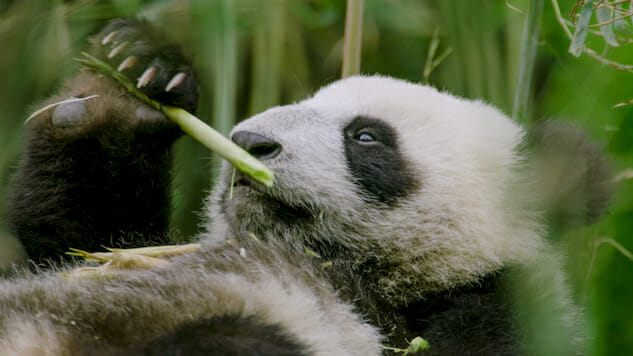Is It Enough that NatGeo’s Hidden Kingdoms of China Showcases Nature but Skips Conservation?
Photo Courtesy of National Georgraphic TV Features Hidden Kingdoms of China
Hidden Kingdoms of China opens and closes with a panda, which is exactly what you would expect from a nature documentary focused on the charismatic megafauna of the region. And that is both the project’s strength and its weakness. The National Geographic documentary explores a variety of different Chinese habitats and regions, highlighting Tibetan foxes, golden snub-nosed monkeys, and snow leopards alongside intriguing micro-life like dragon caterpillars. Narrated by Michelle Yeoh (Crazy Rich Asians, Star Trek: Discovery), Hidden Kingdoms of China is essentially a survey of some of China’s fascinating wildlife, but one that focuses only on the animals’ kingdoms and not on the changing world around them.
We have been treated to a wealth of great documentary filmmaking and docuseries lately that explore Earth on micro levels with ever-evolving tech that’s able to capture these creatures and their habitats with incredible detail. But many, including Netflix’s Our Planet, BBC America’s Seven Worlds, One Planet, and Apple TV+’s The Elephant Queen have also given context to how these habitats came about and how they are changing. Hidden Kingdoms does not; its documentary subjects exist in a beautiful snow globe of isolation. It almost looks like China is uninhabited; and even if these remote regions are largely untouched by civilization (hence the “hidden” part), the impact of China’s growing industrial complex and farming practices (and the mass migration from farms to cities) is surely something that has an impact on the homes and food supplies of its native flora and fauna.
Hidden Kingdoms of China is already juggling a lot, though, in terms of what it wants us to learn over the course of its presentation. Yeoh’s narration is constant, with a very packed script delivering tons of facts. Because of that, both the pacing and the narrative flow can feel scattershot. Unlike Born in China, which focused on three different megafauna’s stories, Hidden Kingdoms tries to fit in far more than its timeframe feels like it can reasonably allow (and in terms of the snow leopard, giant panda, and snub-nosed monkeys, retreads what that other documentary also covered). You really can’t get enough of any of these amazing animals, so I certainly don’t begrudge it that (I audibly gasped on more than one occasion at general cuteness, as well as the inherent nervousness that the animal parents may not, in fact, be able to adequately provide foodstuffs to their tiny offspring). But it feels like Hidden Kingdoms could have easily been expanded into a series that gave more time to the animals being documented, the behind-the-scenes of the filming itself, and of course conservation. (Update: The film will be shown as an expanded 5-hour series airing on NatGeo WILD in March).
As stunning as so much of the filmmaking is (one would expect absolutely nothing less from National Geographic), it just doesn’t feel like it’s enough. On its own, Hidden Kingdoms of China is a very valuable work precisely because it is documenting so beautifully and compellingly the creatures of China’s various remote habitats (it also feels appropriate for children; we’re mostly spared the killing blows of mammals, and despite the amount of carnivorous action, much of it is brief or out of focus). But there’s also a feeling throughout that it needs to do more—essentially, that it needs to acknowledge a human element: How we are interacting (be it the camera operators here or the people of China in general) with these animals and habitats, and what effect we are having on these special places. And it doesn’t have to be negative—though one wonders if the documentary’s co-production with China’s Bilibili platform has flattened out a desire to dive into more ecological context of any kind.
Hidden Kingdoms of China concludes back with our giant panda mama and baby, as mom is pushing him out to explore on his own. The baby has had a nice time hanging out in the safety of this patch of bamboo, but there’s an opportunity now for him to do something more. Nature films and series have the same imperative; they can continue to document the flora and fauna as it was and is, but they really need to push boundaries into making global connections and calling us to action—for the sake of those very pandas. Use my anthropomorphic feelings towards charismatic megafauna against me! Aim right for my heart and wallet! Shock me with context so that I’m calling Senators! Truly, I beg of you, nature docs. It is the absolute least we can do.
Hidden Kingdoms of China premiered Saturday, February 22nd on National Geographic; it will return March 23rd on NatGeo Wild as a 5-hour expanded series.
Allison Keene is the TV Editor of Paste Magazine. For more television talk, pop culture chat and general japery, you can follow her @keeneTV
For all the latest TV news, reviews, lists and features, follow @Paste_TV.